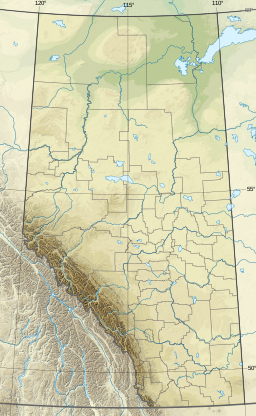St. Mary Reservoir
| St. Mary Reservoir | |
|---|---|
 The disused (right) and replacement (left) spillways of St. Mary Reservoir | |
| Location | Cardston County, Alberta |
| Coordinates | 49°19′15″N 113°12′42″W / 49.32083°N 113.21167°W |
| Basin countries | |
| Max. length | 7.9 km (4.9 mi) |
| Max. width | 9.9 km (6.2 mi) |
| Surface area | 37.5 km2 (14.5 sq mi) |
| Average depth | 10.4 m (34 ft) |
| Max. depth | 56.4 m (185 ft) |
| Surface elevation | 1,100 m (3,600 ft) |
| References | St. Mary Reservoir |
St. Mary Reservoir is a
Wally's Beach
The Wally's Beach site (DhPg-8) at the reservoir is an important site for late
Age
Based on
Paleoenvironment
Eleven thousand years ago the Laurentide Ice Sheet had recently retreated from the area and the site was a windswept, semi-arid plain covered with grasses and low shrubby vegetation, similar to the mammoth steppes of Europe and Asia. The rich open grassland and the reliable supply of water at the river supported herds of large, late Pleistocene mammals and other animals.[2]
Paleontology
The fossil assemblage includes skeletal remains of the extinct musk ox
Footprints and trackways preserved in silt include those of the extinct elephant
In a study published in 2005, measurement of footprints from recorded mammoth trackways showed that only 30% of the animals were juveniles. Healthy herds of African elephants include 50% to 70% young animals, while lower numbers are seen in connection with stresses from poaching. The study is quoting the original radiocarbon date for the footprints at 11,000 to 11,300 years B.P., but both the original and re-examined date place the footprints in the period of human spread across North America, suggesting a correlation between human presence and local decline in herd viability.[5][6]
Archaeology
The herds of animals and the reliable supply of water attracted Paleoindian hunters, and the artifacts recovered from the site suggest that it was a hunting locality. Most of the material consists of stone flakes and flake fragments. A stone
References
- ^ Anonymous. "Atlas of Alberta Lakes". Archived from the original on 2014-12-01. Retrieved 2014-02-01.
- ^ a b c d e McNeil, P., Hills, L.V., Kooyman, B. and Tolman, S. (2004). Late Pleistocene geology and fauna of the Wally's Beach site (DhPg-8), Alberta, Canada. In: J.H. Kelley and B. Kooyman, editors, Archeology on the edge: New perspectives from the northern Plains. University of Calgary Press, 270 p.
- PMID 25831543.
- PMID 28817644.
- ^ "Mammoth footprints track their extinction". New Scientist. 2004-02-07. Retrieved 2017-09-10.
- . Retrieved September 10, 2017.
- S2CID 161413530.


